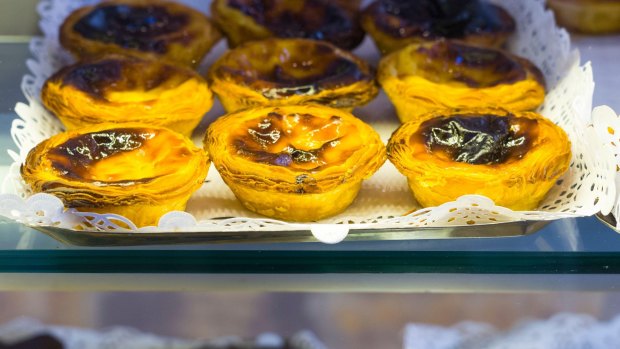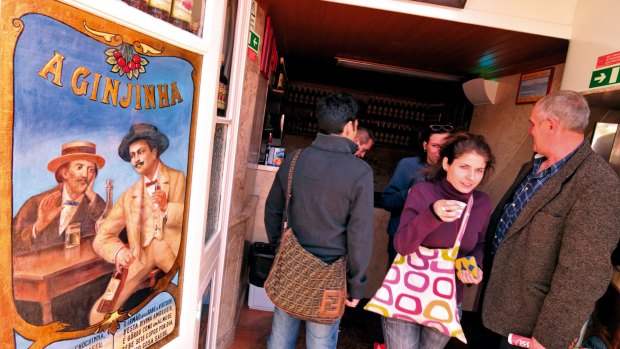This was published 1 year ago
Lisbon, Portugal food tour: Roots, food and culture walking tour
By Kate Armstrong

Famous Portugese custard tarts from Confeitaria Nacional, Lisbon's oldest pastry shop. Credit: Alamy
"We want people to feel hungry now, but not at the end!" Miguel, our guide exclaims cheerfully. I assume he's referring to the local edible samples that we, a group of five, will try on Taste of Lisboa's "Lisbon Roots, Food & Cultural Walk": countless bites at six stops over three hours at designated points in Lisbon's centre. With that, we set off.
The charcuterie Manteigaria Silva, just off Praça do Rossio, a large central square, is a strategic place to start. It opened in 1898, first as a butcher's and then a butter shop. These days the shelves are crammed with Portuguese products: Olive oils. Salt. Tinned fish. Bottles of wine. Above the counter hang a line of Portuguese presuntos (cured hams) while in the glass cabinet below, spreads an array of queijos, cheeses.
Back outside, we gather around a wine barrel and sample a tray that's laden with cheeses, including dollops of Queijo Serra da Estrela, a traditional sheep milk cheese encased in a dry rind.

Customers grab a ginjinha, Lisbon's sour cherry liquor that was invented as a cough medicine.Credit: Alamy
Miguel is like, well, a Portuguese person in a cheese shop. (Read excited). He's like this the entire time, imparting chunks of knowledge, and engaging with us. But back to the queijo.
"Simply open a hole in the top. And scoop out the cheese with a spoon and spread on top of bread," he instructs. (COVID precautions mean they're individual portions for now). The cheese is soft and gooey and dangerously addictive.
Meanwhile, he points out bunches of sausages that hang in the store. The farinheira strikingly resembles a sausage, but comprises flour and seasonings. During the Inquisition, Jewish people ingeniously made these to resemble pork sausages so as not to be identified. The tradition stuck, though vegetarians beware: these days pork fat is included for flavouring. That's hardly odd.
Pork features strongly on Portuguese menus, including our platter. My favourite is the pata negra, melt-in-your-mouth ham from Portugal's acorn-eating wild boar. The extra virgin olive oil from the Douro is equally as delightful – mild and smooth. According to Miguel, Portuguese consume eight litres of oil per person annually, "way more than Spain or Italy!" he adds proudly.
We are too distracted to discuss the country's wine consumption as we sip on a red, a blend of Aragonez (Tempranillo), and French Syrah (Shiraz). The berry flavours reflect that it's from the hot plains of Alentejo.
But if the there's an undoubted winner for Portugal's most consumed product, it's bacalhau, cod. Manteigaria Silva devotes an entire section to this humble fish. Cods, dried and salted, are piled high; their splayed shapes resemble snow angels. Cod has been a staple of Portugal as early as the 15th century and the age of exploration when explorers took dried cod as provisions on their expeditions.
Better still? "It's known as 'pig of the seas' because we can eat all of it [as you can a pig]" says Miguel, pointing to jars crammed with greyish wiggly bits that, it transpires are tongues, cheeks and swim bladders (samos in Portuguese, in case entrails take your fancy).
Cod, in the form of pasteis de bacalhau (cod cakes), is waiting for us at our next stop, O Buraco Snack, a non-descript eatery that serves excellent home-style cooking. These are served with a hot and creamy tomato rice, a common accompaniment, plus a glass of vinho verde (green wine).
Miguel launches into viniculture snippets: Portugal has around 250 types of varietal grapes. And vinho verde is not a grape variety, as many people believe, but a wine region in Portugal's north. There's more insights to come.
We enter Zé dos Cornos, a happy, raucous restaurant. It's warm and fuggy with beer and bodies; locals have gathered for their Saturday lunch. While it's a popular meat spot, we enjoy hearty vegetable soup.
"This is how Portuguese get their vegetables," clarifies Miguel; indeed, main dishes rarely come with greens.
We also chew on a bifana, a popular local snack and the equivalent of a pork schnitzel in a bread roll. Plus local cheeses, including the Queijo Picante da Beira that's joked about informally as being 'between the toe'. It's easy to see (or smell) why. This pungent, face-puckering brute morphs into a fairy when paired with quince jam.
The ghosts of Mouraria's famous fadistas (fado singers) follow us into our drinking stop, Os Amigos da Severa, a tiny hole-in-the-wall bar run by Sr Antonio and named after Maria Severa, a famous fadista who performed here. Fading snaps of clients line the wall. Several senior patrons wait patiently outside, resigned by now to the small tour groups. I feel guilty for interrupting their Saturday routine but, like most Portuguese, they are polite and good humoured about our orchestrated intrusion.
The bar is over 200 years old, and for 45 of these Sr Antonio has served ginjinha, Lisbon's sour cherry liquor that was invented as a cough medicine. (And yes, it still tastes like that).
From here, we stroll casually through the steep alleyways of Mouraria, passing under washing lines and contemporary street art, until we reach Cantinho do Aziz, a no-nonsense Mozambican-themed and owned eatery. We sit under an outdoor canopy while we sip on a beer and munch on steaming, spicy samosas.
Why samosas? Miguel encapsulates the history of Portuguese colonisation: Indian-style cuisine in Portugal is the legacy of Goans. Rather than return to India on their independence from Portugal in 1961, many relocated to Portuguese colonies. Likewise, after Mozambican independence in 1975, many Mozambicans moved to Portugal.
More predictable a delicacy is the custard tart from Confeitaria Nacional, Lisbon's oldest pastry shop. We establish we've already eaten our share of Portugal's famous pastries and compare our favourites. This one is up there. We sigh and pat our expanding bellies. We're full and it's not surprising.
By now, we've consumed more than a few edible titbits. Rather, in just under four hours, we've swallowed whole Portugal's fascinating history and its cuisine culture.
Miguel needn't have worried. He's left us sated in every sense.
THE DETAILS
TOUR
Taste of Lisboa offers several different food-focused experiences around Lisbon including the 3.5 to 4 hour Lisbon Roots, Food & Cultural Walk (cost is €79 or $A125 a person). Other tours visit the gastro-forward market at Campo do Ourique, there are also cooking classes and meals in homes. Private and customised tours available. See tasteoflisboa.com
MORE
Sign up for the Traveller Deals newsletter
Get exclusive travel deals delivered straight to your inbox. Sign up now.